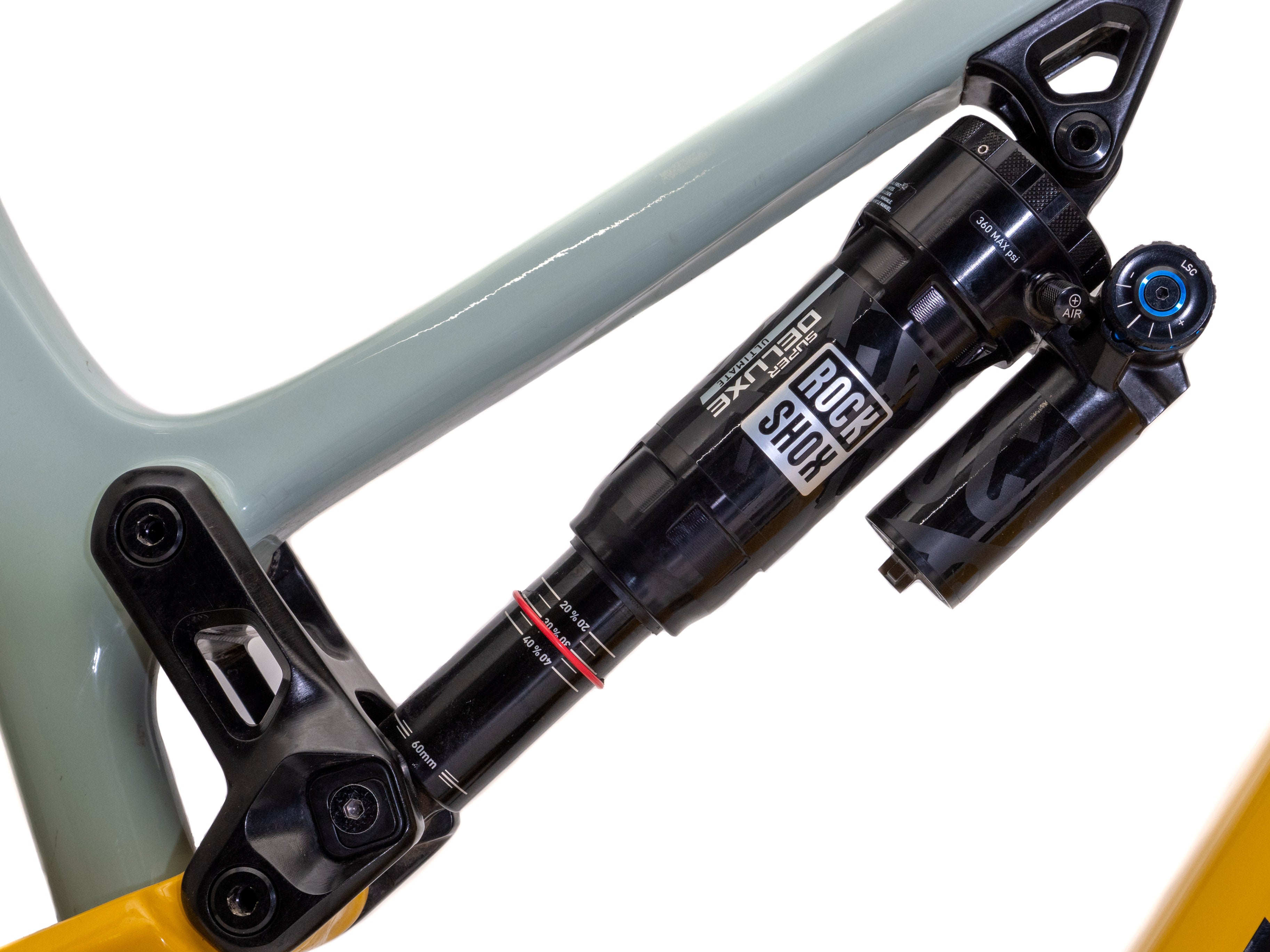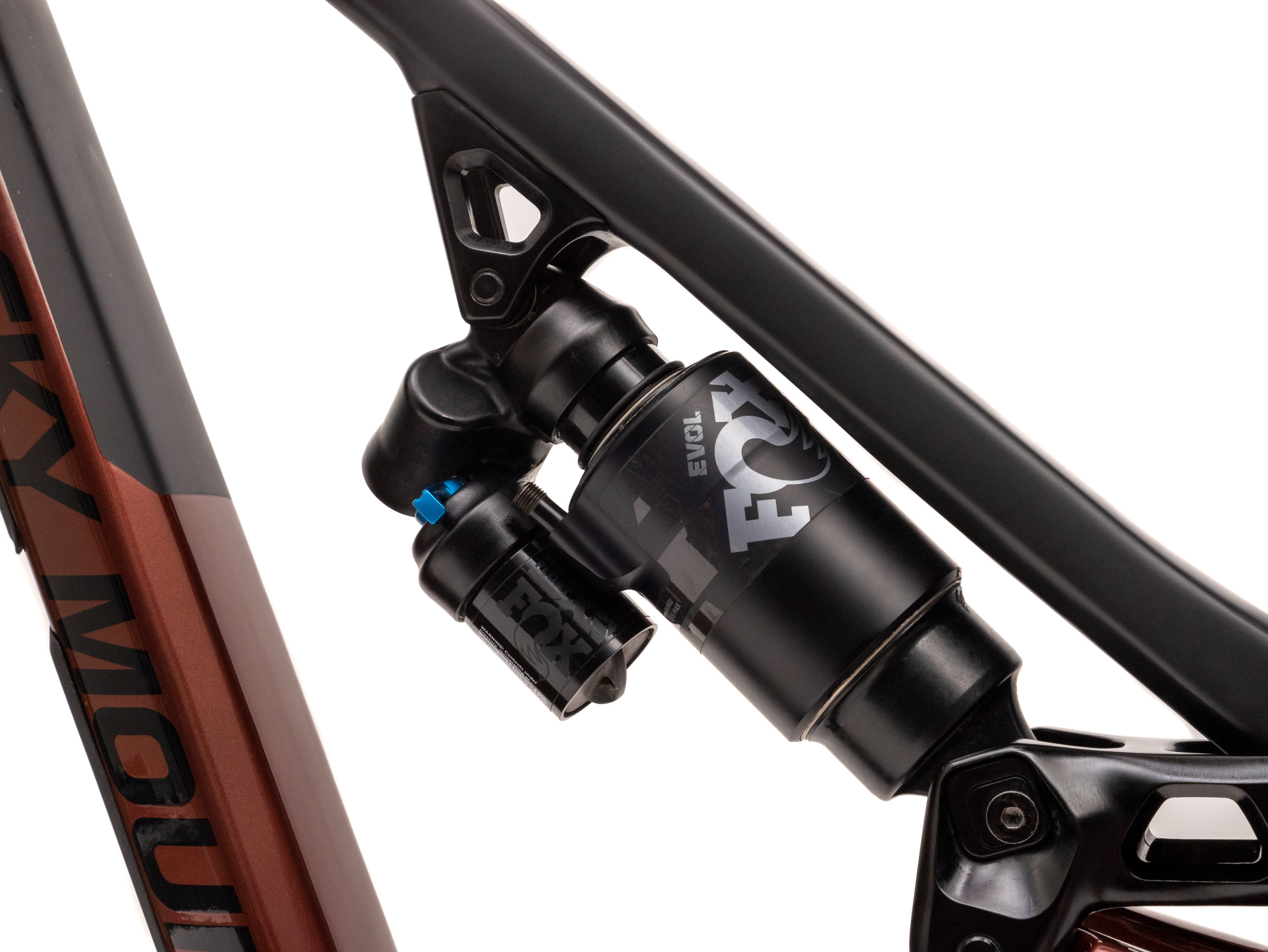Sag – it may only be a three letter word, but it plays a huge role in how your full suspension bike rides. When you sit on your bike, your rear shock will sink a certain amount into it’s travel – this is referred to as sag.
The amount of recommended sag will vary depending on the type of bike that you ride. Typically, enduro/trail bikes fall around 30% recommended sag, while downhill bikes can sometimes be up to 30-35% recommended sag. At the other end of the spectrum, short travel cross country bikes are going to be closer to 25% recommended sag. These numbers are just guidelines though, and may vary depending on suspension kinematics, leverage ratios, and other factors. With the exception of downhill bikes, most full suspension bikes are running air shocks these days. Some of these air shocks have laser-etched guides showing exactly where you sit in your travel, which takes the guesswork out of the sag calculation.
If your shock does have these markings, simply sit on the bike with your geared-up weight and see where your o-ring ends up. Be sure not to bounce up and down, as this will not provide an accurate sag measurement. You can then adjust your air pressure up or down (once you're close, try 10 psi at a time) to hit your exact target sag percentage. But what if your rear shock doesn’t have those sag measurements built-in? Or what if you’re trying to measure sag on a downhill bike with a coil shock? You can try to eyeball the percentage of sag, and generally that will work okay. But if you’re a perfectionist like us, “pretty close” isn’t good enough. Many of us here at Fanatik are pretty particular about the amount of sag we prefer, depending on which bike it is we’re riding. Calculating sag may seem daunting, but it’s actually pretty easy. I’ve broken it down into three easy steps. You’ll need a ruler or measuring tape with millimeters, and a shock pump.
STEP 1 – DETERMINE YOUR TARGET SAG
The first step to the sag calculation is determining your target sag. Target sag is a percentage that is generally recommended by your bike manufacturer, so it’s best to check with them if you’re not sure. As I said above, rough guidelines are as follows:
- XC bikes (80 – 120mm travel): 20% – 30% sag
- Trail/Enduro bikes (120 – 180mm travel): ~30% sag
- Downhill: 30 - 35% sag

RockShox has made setting sag exceptionally easy, with sag percentages shown directly on fork stanchions and shock shafts. Fox riders will want to keep reading to learn how to measure sag, as these sag markings are a RockShox-exclusive feature.
For the purpose of this test, we’re going to calculate sag on a Rocky Mountain Altitude. The target sag percentage for this bike is 30 - 35%.
STEP 2 – MEASURING YOUR SHOCK
The next step involves taking some measurements on the rear shock itself. We are measuring the stroke length of the shock. This measurement can generally be found on the manufacturer’s website, but if you can’t find it, I will show you how to measure it. For the purpose of accuracy, I am measuring in millimeters.
To make this measurement accurately, it’s best to let all the air out of your rear shock, and compress the bike until it reaches bottom-out. Most bikes bottom out at the bottom of the stroke, but some bottom out before they reach the end of their stroke. Mark that point on the shock shaft, or use the sag ring on shock, then decompress the bike and measure the distance from the top of the exposed shaft to the point you marked at bottom-out. This is your stroke length. The stroke length on the Rocky Mountain Altitude is 60mm.

Zero air pressure, shock bottomed out.
As you re-inflate your shock, you should compress the bike every additional 50 psi you add to equalize the air pressure in the positive and negative air chambers of the shock. Simply sit on the bike or otherwise compress the shock. A few centimeters into the stroke you'll likely hear a hiss of air as it flows from the positive chamber into the negative chamber. If you don't hear this, just compress it a few times; it'll equalize as you do this.

STEP 3 – ACHIEVING TARGET SAG
Slide your o-ring to the bottom of the stroke, and sit on the bike with your normal geared-up weight while avoiding any extra bouncing or compressions. Hop off the bike and measure the distance between the o-ring and the bottom of the stroke. That distance should be as close to recommended sag as possible; for the Altitude it is 30 - 35%, which equates to 18 - 21mm of the available stroke.
If your measurement is too low, that means you have too much pressure in your shock, and you need to reduce the air pressure. I recommend reducing pressure in 10 psi increments until you reach your target measurement. If you’re using a coil shock, that means you need get a lighter spring (your pre-load collar should never be tightened more than two or three turns beyond where it keeps the spring secure).
If the number is too high, that means you need increase air pressure to reach your target measurement. Or if you’re using a coil shock, you will need to get a stiffer spring.

More Articles You Might Like
TRP EVO 12 Drivetrain Review // TRP Compared to SRAM
Product Reviews / BK Stancil / Mar 15, 2024
Much like TRP has managed to establish the DH-R EVO brakes as a viable stopping powe...
Read MoreHope EVO Cranks // Comparing 155, 165, and 170mm Cranks for Mountain Biking
Product Guides / BK Stancil / Mar 04, 2024
Read More
SRAM Maven Review // New SRAM Brakes Compared to Code RSC
Product Reviews / BK Stancil / Feb 22, 2024
SRAM has reacted to the increasing demands of modern mountain biking with their most...
Read MoreView More:

